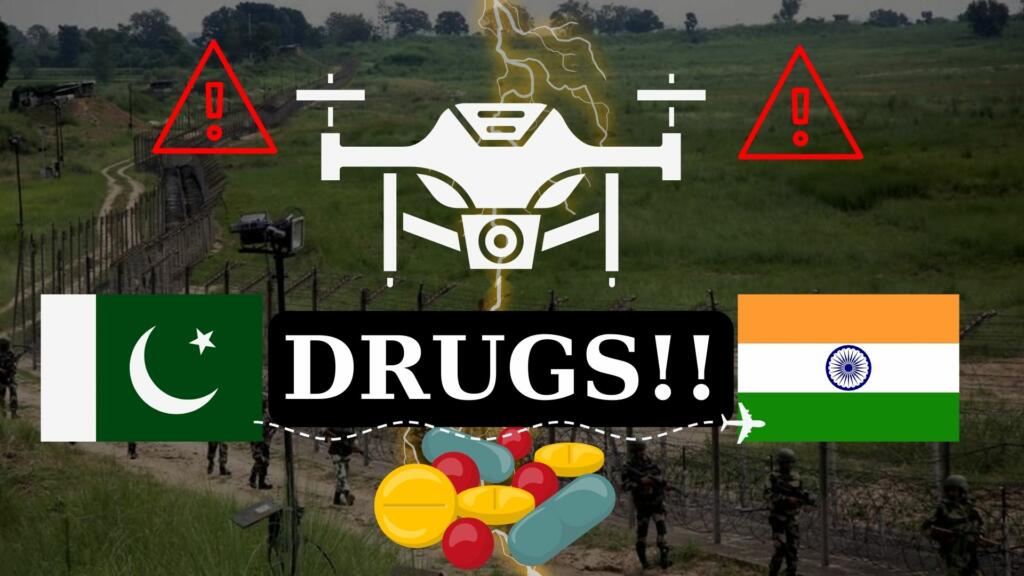The escalating use of drones for smuggling activities along the Pakistan-India border in Punjab has become a growing concern, marking a dual threat of terrorism and drug trafficking. In recent years, the frequency of incidents has risen, with Pakistani smugglers taking advantage of weather conditions, particularly dense winter fog, to conduct covert drone sorties.
Escalation of Drone Smuggling Incidents
The use of drones for smuggling activities along the Pakistan-India border in Punjab has been a recurring issue in recent years. Here’s a summary of previous incidents related to this:
2019: The first case of a drone carrying drugs from Pakistan was reported. Two drones were shot at and recovered by Border Security Force (BSF) personnel.
2020: No reported cases of drone smuggling were recorded during this year.
2021: One case of drone smuggling was reported along the border.
2022: The situation escalated, with at least 22 drones seized by the BSF. This marked a significant increase from the previous year.
2023: The problem continued to grow, with the recovery of at least 90 drones by the BSF. The recovered contraband included 494 kg of heroin, 37 weapons, and 601 rounds of ammunition.
Exploiting Weather Conditions
Pakistani smugglers have adeptly exploited weather conditions, specifically dense fog during the winter months, to facilitate their smuggling activities. Drones equipped with GPS devices navigate through low visibility and drop illicit consignments in specific locations. The interview with four men from Tarn Taran district, who were arrested for receiving consignments, revealed that smugglers take advantage of low visibility, using GPS devices to drop contraband unnoticed. Specific intelligence led to the arrest of two men on January 30, who, while in custody, conducted eight sorties, dropping nearly 9 kg of heroin, a pistol, and cartridges.
The Role of Villagers in Smuggling Networks
Investigations into the involvement of villagers in border areas with smugglers based in Pakistan highlight the need for a comprehensive approach. The nexus between local communities and smuggling networks poses a significant challenge for law enforcement. The arrested individuals mentioned that smugglers often exploit the cooperation of villagers to establish drop zones and receive illicit consignments. This emphasizes the importance of community engagement and awareness to break the link between villagers and smuggling networks.
Also Read: BLA destroys Pakistani Army, Captures two Critical towns
Countermeasures by Indian Security Forces
In response to the escalating threat, the BSF has taken proactive measures to strengthen its intelligence network and increase surveillance during periods of low visibility, particularly dense fog. Anti-drone machines are being tested at some border outposts to detect and neutralize drones entering Indian airspace. Despite challenges posed by fog and low visibility, security forces have been actively involved in shooting down drones, recovering contraband, and attempting to disrupt the logistics of the smuggling networks.
Continuous Threat Despite Security Efforts
The persistent nature of drone incursions illustrates the challenges faced by Indian security forces. Despite their efforts to shoot down drones and recover dropped consignments, smugglers continue their activities. For instance, in Dhanoe Khurd village, despite security forces shooting down a drone, Pakistani smugglers continued to send multiple drones in quick succession. This showcases the adaptability and determination of the smuggling networks, making it a continuous threat for the security forces.
Data on Recovered Contraband
Official data on the recovered contraband paints a grim picture of the impact of these smuggling activities. In the past years, the BSF recovered significant quantities of heroin, weapons, and ammunition sent from Pakistan using drones. The sheer scale of the recovered items emphasizes the urgency of addressing the root causes and disrupting the networks responsible for these activities.
The dual threat of terrorism and drug trafficking facilitated by Pakistani smugglers using drones along the Pakistan-India border demands a comprehensive and collaborative approach. This includes strengthening intelligence networks, enhancing technological capabilities, and engaging local communities to break the nexus with smuggling networks. The evolving nature of these challenges underscores the need for constant adaptation and innovation in the strategies employed by Indian security forces to secure the border and protect the well-being of the region.
Also Read: Imran: Gone, Baby Gone!
